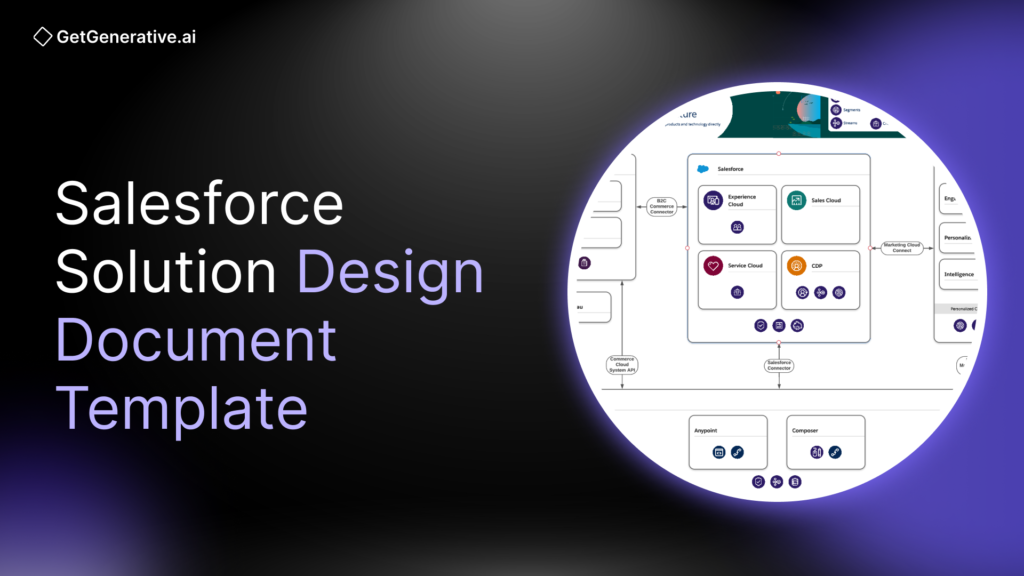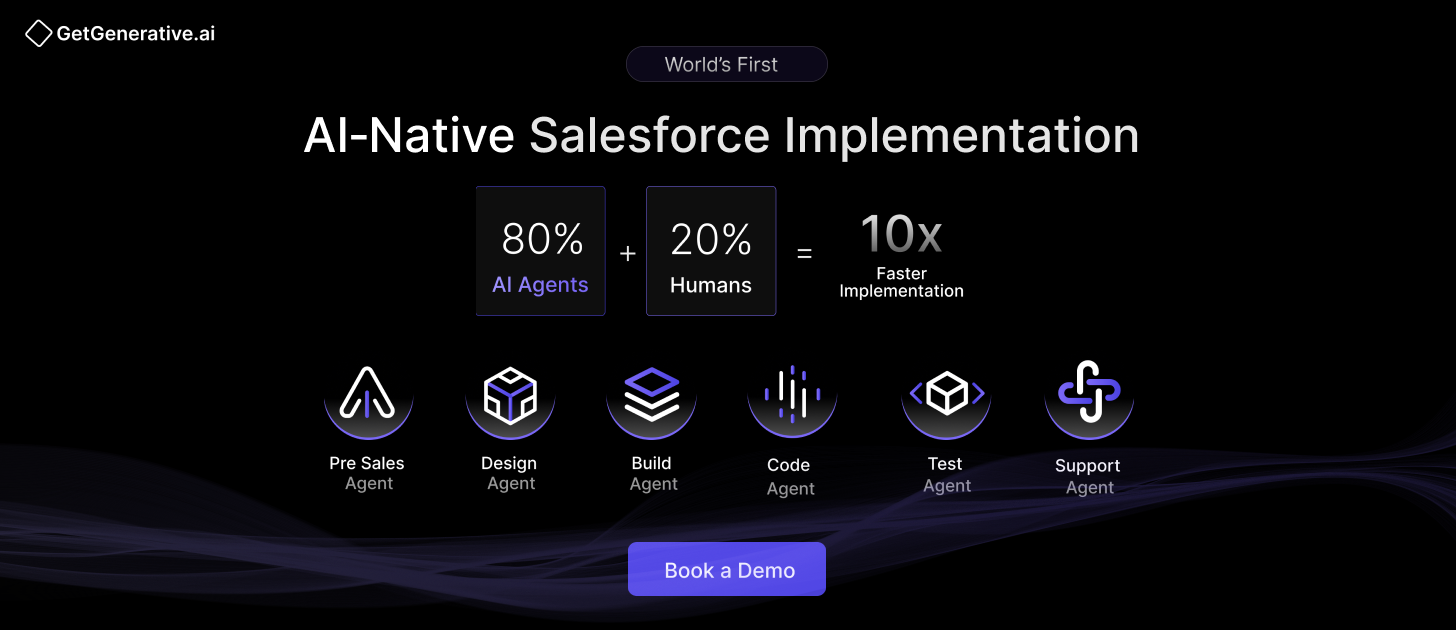Salesforce Solution Design Document Template
Salesforce is the digital nervous system of customer-centric operations. Yet despite its capabilities, 70% of digital transformation initiatives fail to meet their goals, often due to misaligned execution and poor upfront planning.
With Salesforce commanding 21.7% of the global CRM market, failure isn’t a risk organizations can afford.
The solution?
Strategic design and documentation — specifically, the Salesforce Solution Design Document (SDD).
For seasoned Salesforce professionals and enterprise executives alike, the SDD acts as the architectural blueprint that translates high-level business goals into actionable technical design. It prevents miscommunication, reduces risk, and keeps teams aligned from the start of the implementation through go-live.
This blog provides a comprehensive guide to creating a Salesforce SDD that drives clarity, accountability, and results. Whether you’re a Salesforce architect, delivery lead, or CXO, this resource outlines key sections, best practices, and real-world case insights to help your organization build right, the first time.
Understanding the Salesforce Solution Design Document (SDD)
A Salesforce Solution Design Document bridges the gap between business intent and technical execution. It defines not only what a solution must accomplish, but also how Salesforce’s architecture, configuration, and integrations will achieve it.
Unlike basic requirements documents, an SDD is solution-oriented. For example, it won’t just say “enable automated case routing,” but instead outline whether this will be achieved via standard assignment rules, Omni-Channel, or custom Apex logic, and why that choice supports scalability and usability.
HLD vs. LLD: What’s the Difference?
Most enterprise Salesforce implementations split design documentation into:
- High-Level Design (HLD): Focuses on architecture, systems involved, and solution overview — geared toward business and executive stakeholders.
- Low-Level Design (LLD): Provides configuration details, object structures, field-level mappings, security models, and integration specifics — intended for technical teams.
Often, the SDD begins as an HLD and evolves to include LLD details. It becomes the single source of truth across the implementation, reducing the risk of misaligned development and scope creep.
Why the SDD Is a Strategic Asset for Enterprises
The SDD is not just documentation — it’s a risk management and alignment tool. For large organizations, especially those implementing Salesforce across regions or integrating with systems like ERP or e-commerce platforms, the SDD mitigates the most common pitfalls:
1. Aligns Stakeholders
In enterprise projects, lack of clarity leads to waste. According to PMI, $97 million is wasted for every $1 billion invested due to project misalignment and poor requirements. A thorough SDD ensures that executives, developers, consultants, and admins are all working from a shared vision.
2. Surfaces Risks and Assumptions Early
By forcing design decisions upfront — such as “custom vs. out-of-the-box,” “real-time vs. batch integrations,” or “single-org vs. multi-org” — the SDD uncovers dependencies, assumptions, and compliance concerns before build begins.
3. Promotes Salesforce Best Practices
SDDs are the place to encode best practices like:
- Clicks over code
- Use of standard data models
- Reusability and scalability
Senior architects can guide the solution using Salesforce’s architectural guardrails.
4. Improves Governance and Executive Confidence
For CXOs, an SDD translates complex tech into understandable outcomes:
“Implementing Service Cloud with Omni-Channel routing is expected to reduce average case resolution time by 20%.”
It enables milestone reviews, executive sign-off, and forms a benchmark for project governance.
Core Components of a Salesforce Solution Design Document
A robust Salesforce SDD is structured around the following core sections:
1. Executive Summary
Concise overview for non-technical stakeholders:
- Business drivers (e.g., “inefficiencies in sales quoting”)
- Key goals and KPIs
- Summary of Salesforce solution (e.g., “CPQ + ERP integration to streamline quote-to-cash”)
2. Business Requirements and Scope
Outlines:
- High-level objectives and success metrics
- Primary business requirements or epics
- What’s in scope and out of scope
- A requirements traceability matrix linking business needs to solution components
This section prevents scope creep and ensures traceability when requirements evolve.
3. Current State and Proposed Architecture Overview
Before jumping into the to-be design, a strong SDD begins by assessing the current state — what systems, tools, or manual processes are being replaced or integrated with Salesforce. This section answers:
- What legacy systems are in place (e.g., on-premise CRM, ERP, spreadsheets)?
- What are the major pain points (e.g., data silos, poor reporting, lack of automation)?
- What is the current user experience or process flow?
This sets the stage for why transformation is necessary and positions Salesforce as the enabler.
Target Architecture Overview
This should include:
- Salesforce products and org structure (e.g., single-org vs multi-org)
- Connected systems (ERP, e-commerce, data warehouse, etc.)
- Middleware or integration layer (e.g., MuleSoft, Informatica)
- Direction and flow of data (inbound, outbound, bi-directional)
Every box and arrow in the diagram should be explained in the accompanying text. For example:
“Salesforce will integrate with SAP ERP via MuleSoft to fetch product availability and pricing in real-time, enabling accurate CPQ functionality.”
Be sure to explain key design decisions such as:
- Why was one middleware chosen over another
- Whether APIs are synchronous or asynchronous
- Why multi-org was selected (e.g., due to data residency regulations)
Business Process Flows
Include diagrams that map Salesforce features to specific business processes. For example:
- Lead lifecycle: from creation (via web-to-lead) to qualification, assignment, and conversion
- Case management: from customer submission to agent routing, SLA enforcement, and resolution
These to-be process flows ground the architecture in real-world functionality and clarify how Salesforce will support or optimize daily operations.
4. Detailed Design: Data, Security, Application Logic, Integrations
This section is the most technical and should serve as a reference for developers, testers, and solution architects.
Data Model Design
Document:
- Standard and custom objects
- Key fields and relationships (lookup, master-detail)
- Data volumes and storage considerations
- Naming conventions and API names
- Data archiving strategies (e.g., move closed cases older than 3 years to BigObjects)
Include ERDs (Entity Relationship Diagrams) where possible. Also note any assumptions:
“Product catalog will be synced nightly from SAP and is considered read-only in Salesforce.”
Security Model
Capture:
- Role hierarchy
- Sharing rules (organization-wide defaults, criteria-based sharing, etc.)
- Profile and permission set design
- Field-level security
- Shield Platform Encryption or field masking for PII/PHI
- Region-based access restrictions (important for GDPR, HIPAA)
This ensures regulatory compliance and helps reviewers assess risks early.
Application Logic
Clarify how automation is implemented, and follow the “declarative first” principle:
Business Requirement | Salesforce Feature | Notes |
Auto-assign cases based on region | Omni-Channel Routing | Scales better than custom triggers |
Validate close date for opportunities | Validation Rules | Avoids Apex for simple logic |
Complex lead scoring | Apex Trigger + Custom Metadata | Due to scoring weights pulled from external systems |
Also outline usage of:
- Flows (Record-Triggered, Scheduled)
- Process Builder (only if legacy)
- Approval Processes
- Apex Classes/Triggers
- Lightning Web Components
- Einstein AI or Next Best Action, if applicable
Integration Design
Detail each integration scenario using a consistent format:
Integration | Direction | Method | Frequency | Comments |
SAP → Salesforce (Product Info) | Inbound | REST API (via MuleSoft) | Nightly | Read-only data |
Salesforce → ERP (Order Info) | Outbound | Synchronous API | Real-time | For immediate fulfillment |
Salesforce ↔ Marketo | Bi-directional | Middleware sync | Near real-time | Lead and campaign sync |
Include sample field mappings or JSON payloads if useful.
Also Read – Salesforce Requirements with AI: Epics, User Stories & Acceptance Criteria
Best Practices for Creating a High-Impact SDD
The best Salesforce SDDs don’t just document — they guide, align, and protect the implementation. Here are expert-recommended practices:
✅ Favor Simplicity
- Always default to configuration before code.
- Use standard objects and fields unless there’s a compelling reason not to.
- Avoid over-engineering: prioritize scalability, usability, and low maintenance.
“The best Salesforce solutions are invisible — users shouldn’t know if it’s Flow or Apex underneath.”
✅ Collaborate Early
- Run design review workshops with business stakeholders, tech leads, and security teams.
- Secure executive sign-off on architecture and scope before build starts.
- Validate assumptions early (e.g., legacy data quality, integration feasibility).
✅ Explain the “Why” Behind Design Choices
Don’t just state what you’re doing — explain why it was chosen. This builds trust and creates a learning artifact for future teams.
“Apex was used over Flow here due to bulk processing limits in Flow for high-volume transaction records.”
✅ Keep the SDD Live
- Version-control your SDD (e.g., via Confluence, SharePoint, or Git).
- Update it as scope evolves or when implementation deviates from the original plan.
- Refer to it during sprint planning, testing, and UAT phases.
A static document is forgotten. A living SDD becomes a powerful project guide and legacy asset.
Also Read – How to Generate Apex Code with AI
Case Study: How a Strong SDD Enabled a Global Salesforce Rollout
Let’s look at how a comprehensive SDD helped a multinational enterprise avoid project failure and drive measurable business outcomes.
Client Profile:
A Fortune 500 global manufacturing firm with operations across North America, EMEA, and APAC regions. The company aimed to consolidate three regional CRM platforms into a unified Salesforce instance supporting global sales, customer service, and partner management.
Challenge:
Previous CRM projects at the organization had suffered from:
- Conflicting regional priorities
- Inconsistent business processes
- Poor visibility into customer data
- Cost overruns and delayed go-lives
To avoid repeating these mistakes, the leadership mandated a design-first approach anchored by a robust Salesforce Solution Design Document.
Solution:
The program’s lead architect coordinated with regional stakeholders to co-develop an enterprise-grade SDD that included:
- A global Salesforce architecture integrated with SAP ERP and Adobe Experience Cloud
- A unified data model for customers, products, and service cases — including field-level definitions, master data sources, and deduplication logic
- A role-based security model with data residency controls to comply with GDPR and regional privacy laws
- Clearly defined region-specific variations in workflows (e.g., post-sales support processes differed in EMEA vs. APAC)
- A detailed integration matrix outlining 15+ system touchpoints with direction, data mapping, and frequency
- Assumptions and constraints (e.g., ERP will expose real-time APIs by Q2; product hierarchy is standardized globally)
Impact:
- On-time, on-budget launch — a first for the client’s CRM initiatives
- ~20% improvement in case resolution times in the first 6 months
- +35% user adoption versus past projects, thanks to consistent UX and stakeholder buy-in
- The SDD was reused as a template for onboarding future business units, shortening ramp-up for new rollouts
This case reinforces the idea that a strong SDD is not just a documentation deliverable — it’s a strategic multiplier for scale, speed, and stakeholder alignment.
Conclusion
In an era where digital transformation can determine competitive advantage, an excellent Salesforce Solution Design Document is your edge. It separates organizations that improvise their way into technical debt from those that lead with intention.
Want a simpler way to manage your next Salesforce project?
GetGenerative.ai brings everything into one place — from drafting proposals to going live — powered by AI agents that work alongside your team.
If you’re curious to see how it fits into your workflow, schedule a quick demo at your convenience.




